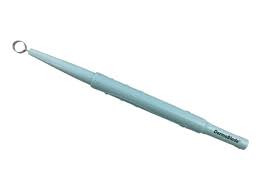
The area is numbed using a tiny needle. The tumor is scraped out using a sharp instrument, called a curette (see photo below), and the base of the wound is burned using an electrical instrument called a Hyfrecator (see photo below), or, less commonly, with a laser. After the treatment, an open sore is left that takes several weeks or even months to heal. Daily wound care is required until the open sore heals over completely. The final result is often a permanent white scar or pink raised scar that can itch or be tender. This treatment is commonly performed for superficial basal cell carcinoma, nodular basal cell carcinoma, squamous cell carcinoma in situ, and squamous cell carcinoma with cure rates as high as 95%. Due to a higher recurrence rate, this treatment is not recommended for recurrent tumors (tumors that have been treated and have come back), infiltrative basal cell carcinoma, morpheaform (sclerosing) basal cell carcinoma, or very large tumors. This treatment is the simplest to perform from a surgical standpoint, is the least expensive procedure, but often takes the longest to heal of any surgical procedure.
